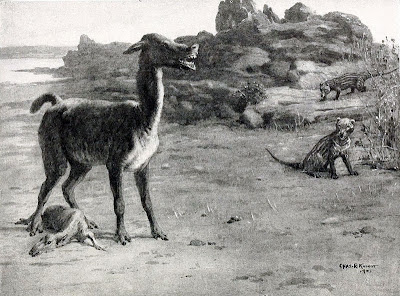The Cloud was hailing grasshoppers. The cloud was grasshoppers. Their bodies hid the sun and made darkness. Their thin, large wings gleamed and glittered. The rasping whirring of their wings filled the whole air and they hit the ground and the house with the noise of a hailstorm.
Laura tried to beat them off. Their claws clung to her skin and her dress. They looked at her with bulging eyes, turning their heads this way and that. Mary ran screaming into the house. Grasshoppers covered the ground, there was not one bare bit to step on. Laura had to step on grasshoppers and they smashed squirming and slimy under her feet.
--Laura Ingalls Wilder, On the Banks of Plum Creek
In 1875, the American Midwest experienced the largest single locust swarm ever recorded. It covered an estimated area of 198,000 square miles, considerably larger than the state of California, and the person who estimated its size recorded that it took five days to pass by. The species composing this gigantic swarm was the Rocky Mountain locust Melanoplus spretus, and at the time it was America's scourge. Locust swarms in 1874, following a dry summer, had devastated Midwestern agriculture: crops were destroyed, livestock and people starved to death. After the 1874 swarms, it was estimated that only one family in ten had stored enough food to last the winter. The entire future of the region became uncertain: one homesteader observed that, "Wheat and grasshoppers could not grow on the same land, and the grasshoppers already had the first claim".
But then something extraordinary happened. After 1875, grasshopper numbers began declining. Before thirty years had passed, the Rocky Mountain locust was not merely no longer a significant pest, it had become completely extinct. No individuals of the species have been seen alive since 1902. The reasons for this precipitous decline have been much debated, but a prominent suspect has been the conversion of large areas of prairie into managed farmland.
I was reminded of the locusts by Alex Wild's recent comments on the decline of the monarch butterfly, a species that, while not yet extinct, has had a precipitous decline in recent years in North America. Alex notes that:
I don’t have many photographs of monarchs. A few bland shots of larvae, a handful of adults on flowers. I never felt any urgency. They were as common as dirt. I just sort of assumed monarchs would always be around to photograph later.
Silly me.
The Rocky Mountain locust, of course, is not the only example of a once-abundant species becoming extinct in historic times. The passenger pigeon Ectopistes migratorius and the Carolina parakeet Conuropsis carolinensis are two other well-known examples. September 1st this year will mark the hundredth anniversary of the death of Martha, the last known surviving passenger pigeon, in Cincinnati Zoo.
Population numbers are often used as a heuristic for estimating extinction threat, at least in the popular media, and often influences priorities for conservation efforts. A species with a surviving population of 1000 individuals is considered more endangered than one with 100,000 individuals. But examples such as the Rocky Mountain locust show us that even the most unimaginably abundant of animals may not be immune from sudden population crashes. Conversely, some animals persist despite very low population sizes. The black robin Petroica traversii has survived its population being reduced to only five individuals, including only a single breeding female (granted, its survival has received more than a bit of a helping hand from some very intensive conservation efforts, and is by no means typical).
So my question is this: what is the correlation between population size and extinction risk? How much does a smaller population size increase the risk of extinction, or is it secondary to factors such as habitat disturbance? I'm not implying that I think these questions haven't been asked before (I'm sure that they have), they're just something I've been wondering recently myself.



























